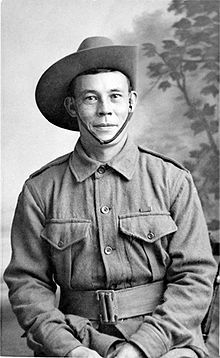Billy Sing | |
|---|---|
 W. E. Sing, c. 1918 Australian War memorial P03633.006 | |
| Birth name | William Edward Sing |
| Nickname(s) | The Assassin, The Murderer, Billy |
| Born | 2 March 1886 Clermont, Queensland |
| Died | 19 May 1943 (aged 57) Brisbane, Queensland, Australia |
| Buried | Lutwyche Cemetery, Brisbane |
| Allegiance | Australia |
| Service | Australian Imperial Force |
| Years of service | 1914–1918 |
| Rank | Trooper |
| Service number | 355A |
| Unit | 5th Light Horse Regiment 31st Infantry Battalion |
| Battles / wars | |
| Awards | Distinguished Conduct Medal Mentioned in Despatches Croix de guerre (Belgium) |
| Spouse(s) |
Elizabeth A. Stewart
(m. 1917) |
| Other work | Stockman, sheep farmer, gold miner |
William Edward Sing, DCM (3 March 1886 – 19 May 1943), known as Billy Sing, was an Australian soldier of Chinese and English descent who served in the Australian Imperial Force during World War I, best known as a sniper during the Gallipoli Campaign.[1][2][3][4][a] He took at least 150 confirmed kills during that campaign, and may have had over 200 kills in total.[3][4] However, contemporary evidence puts his tally at close to 300 kills.[5] Towards the end of the war, Sing married a Scottish woman, but the relationship did not last long.[2] Following work in sheep farming and gold mining, he died in relative poverty and obscurity in Brisbane during World War II.[2][6]
- ^ Hamilton (2008), p. 5.
- ^ a b c Tate, B. (1993): Trooper William Edward (Billy) Sing, DCM, Croix de Guerre, 1886–1943: "The Assassin of Gallipoli" Archived 12 May 2010 at the Wayback Machine Courier Mail Weekend (24 April 1993). Retrieved 26 May 2010. Alternative copy Archived 16 March 2018 at the Wayback Machine Retrieved 11 June 2010.
- ^ a b Reed, F. (1916): Billy Sing: Famous Australian sniper Archived 11 May 2020 at the Wayback Machine The Mercury (13 March 1916, p. 4). Retrieved 26 May 2010.
- ^ a b Gallipoli and the Anzacs: The Anzac Walk – Artillery Road Archived 25 May 2010 at the Wayback Machine (2009). Retrieved 26 May 2010.
- ^ Hamilton (2008), p. 6.
- ^ Hamilton (2008), p. 8.